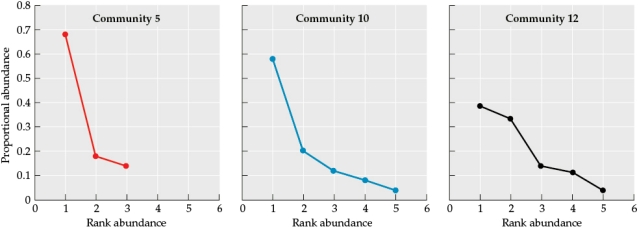Essay
Refer to the table and figure.
 Figure 3
Figure 3
 Suppose you are researching an ecological community in a new study area. You divide your study area into quadrats and sample one quadrat a day to determine the species that occupy the area and how many individuals of these species are present. Assume that by the end of your sampling efforts, you have identified all of the species that occur in the study area. Use the proportional abundances of species that you calculated and graphed in Table 4 and Figure 3 to answer the following questions:
Suppose you are researching an ecological community in a new study area. You divide your study area into quadrats and sample one quadrat a day to determine the species that occupy the area and how many individuals of these species are present. Assume that by the end of your sampling efforts, you have identified all of the species that occur in the study area. Use the proportional abundances of species that you calculated and graphed in Table 4 and Figure 3 to answer the following questions:
a) How are the roles of foundational species and keystone species defined? What are the similarities and differences in terms of how each functions in its community?
b) Based on just the abundance data in Table 4, create a new table (this will be referred to as Table 6) showing all of the species that could be considered foundational species or keystone species in each community.
c) What two types of additional information would you need to determine whether these species were indeed foundational species or keystone species? How could you obtain this information? Based on the definitions of foundational and keystone species, how would you use this information to determine whether the species were foundational or keystone species?
Correct Answer:

Verified
a) Both foundational and keystone specie...View Answer
Unlock this answer now
Get Access to more Verified Answers free of charge
Correct Answer:
Verified
View Answer
Unlock this answer now
Get Access to more Verified Answers free of charge
Q1: Which statement about foundation species is true?<br>A)
Q2: Refer to the figure.<br><img src="https://d2lvgg3v3hfg70.cloudfront.net/TBO1115/.jpg" alt="Refer to
Q3: Refer to the table and the figure.<br>Table
Q5: Refer to the figure.<br><img src="https://d2lvgg3v3hfg70.cloudfront.net/TBO1115/.jpg" alt="Refer to
Q6: Refer to the tables.<br> <img src="https://d2lvgg3v3hfg70.cloudfront.net/TBO1115/.jpg" alt="Refer
Q7: Refer to the figure.<br><img src="https://d2lvgg3v3hfg70.cloudfront.net/TBO1115/.jpg" alt="Refer to
Q8: Which conclusion was the primary finding of
Q9: How many total trophic levels are present
Q10: Which statement best describes the difference between
Q11: Refer to the table.<br>Table 9<br> <img src="https://d2lvgg3v3hfg70.cloudfront.net/TBO1115/.jpg"